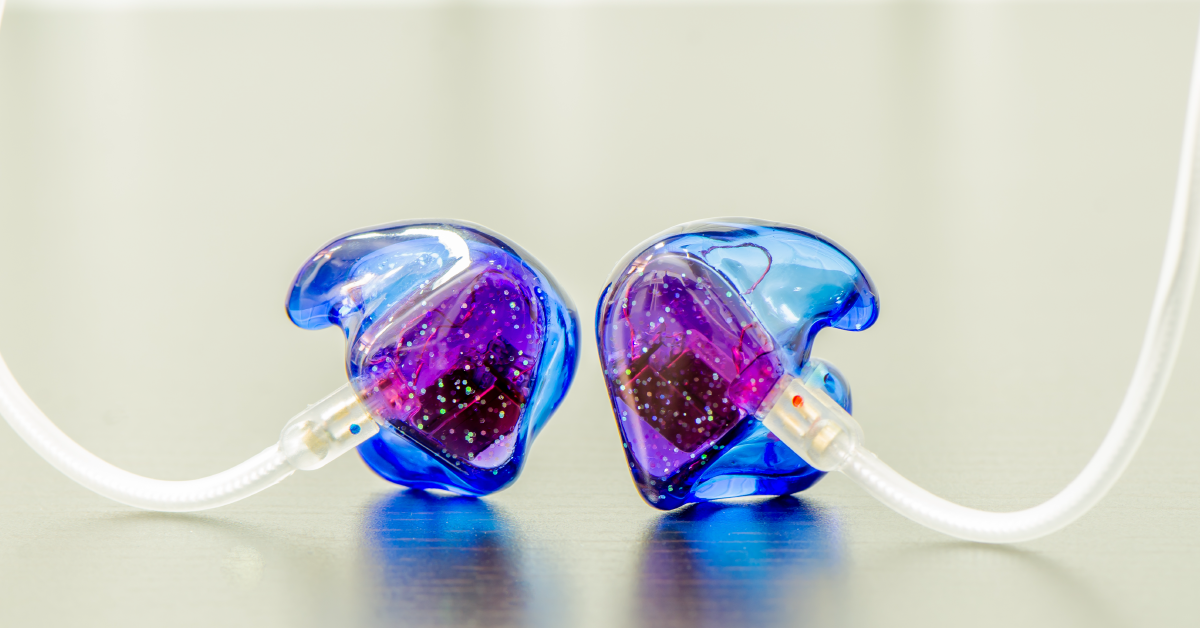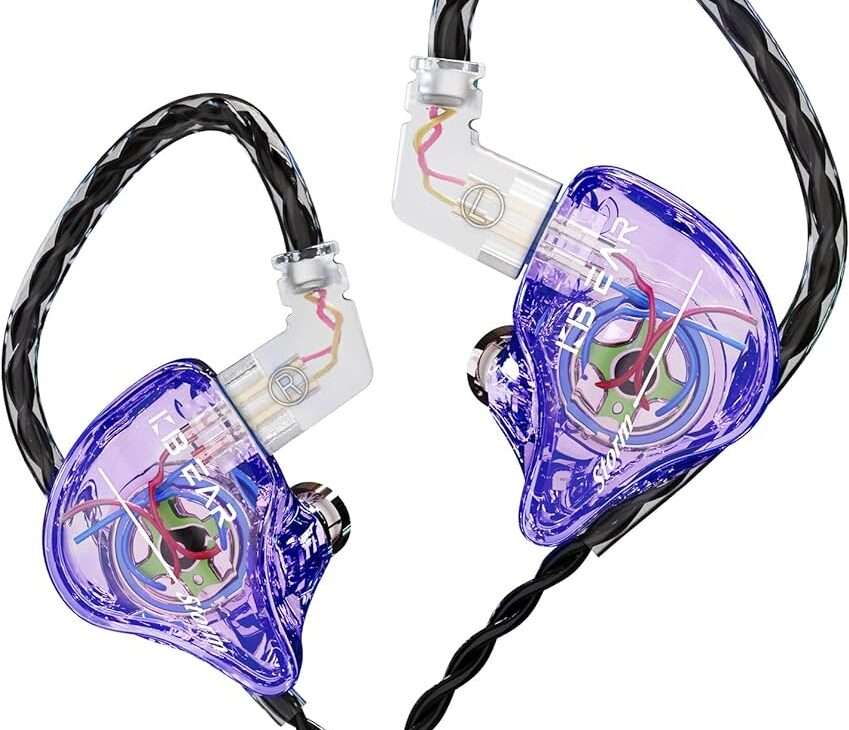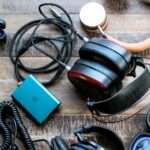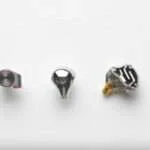In-ear monitors for singers provide excellent sound isolation, clarity, and comfort, making them essential for live performances and studio recordings. They help singers hear themselves and the music accurately, enhancing performance.
These compact audio devices fit snugly in the ear and are favored by vocal performers for their clear, isolated sound, enabling better pitch control and a closer connection with the music.
By reducing the reliance on traditional, bulky stage monitors, IEMs offer artists greater freedom of movement and comfort without compromising on sound quality.
They also protect against long-term hearing damage by eliminating the need for high onstage volume levels. Ideal for singers of all levels, in-ear monitors are an essential tool for a professional-sounding performance and vital for those looking to maintain vocal excellence and stage presence.

Credit: www.amazon.com
The Role Of In-ear Monitors In Live Performances
Imagine a world where every note hits the right chord, and every lyric flows flawlessly. This is the world of In-ear monitors (IEMs) created for singers. Live performances come with unpredictable sounds and distractions.
In-ear monitors empower singers to deliver captivating performances. They ensure that artists hear exactly what they need to. Let’s dive into how IEMs transform the stage experience.
Enhancing Vocal Clarity
Vocal clarity is everything to a singer. With IEMs, performers hear their voices directly. This direct sound reduces strain and improves pitch. Clarity in live settings heightens performance quality. Here is how IEMs enhance vocal clarity:
- Direct Sound: Singers hear their voices without delays or echoes.
- Personal Mix: Balanced audio as per the singer’s preference.
- Consistent Quality: Same sound experience, irrespective of venue size.
Crowd Noise Isolation
Audiences are loud. This noise can overwhelm you. IEMs create a sound barrier between the artist and the crowd. By isolating outside noise, singers focus solely on the music. This isolation brings benefits:
| Benefit | Description |
| Noise Reduction | Less crowd noise means more focus on performance. |
| Preventing Hearing Damage | Protects ears from harmful decibel levels. |
| Better Sync | Artists stay in rhythm with the band and background tracks. |
With these advantages, singers perform at their best. In-ear monitors are vital for any live performance. They shape the way artists interact with their music and audience.
Comparing Traditional Stage Monitors With In-ear Systems
For singers, hearing themselves clearly on stage is essential. With traditional wedge monitors and in-ear monitors available, choosing the right system is crucial to performance. Each setup offers distinct experiences on stage.
To make an informed choice, understanding the benefits and drawbacks of both systems is key.
Pros And Cons Of Wedges
Wedge monitors, known as stage or floor monitors, have been the standard for live performances for decades. These loudspeakers point upwards, allowing performers to hear themselves during a show.
| Pros | Cons |
| No need to wear anything. Simple to use Good for interaction | Cause feedback. Occupies stage space. Limited personal mix |
Advantages Of In-ear Monitors
In contrast, in-ear monitors (IEMs) provide a personalized audio feed directly into the ears of the performer. Let’s explore their numerous advantages:
- Clear sound quality: With In-Ear Monitors, singers can experience crystal-clear sound reproduction, free from the distortion and interference that can plague traditional stage monitors. This pristine audio quality allows performers to hear every nuance of their vocals and music, ensuring a more polished and professional performance.
- Isolation from noise: IEMs block out ambient noise, allowing singers to focus solely on their performance without distraction.
- Custom mix: One of the greatest advantages of In-Ear Monitors is their ability to provide customized monitoring mixes for each performer. With a personal mixer or a dedicated monitor engineer, singers can adjust the levels of their vocals and instrumentals to suit their individual preferences, eliminating the need to rely on a one-size-fits-all monitor mix.
- Health benefits: By reducing the need for loud stage monitors, IEMs help protect singers’ hearing from long-term damage caused by excessive noise exposure.
- Mobility: Unlike bulky stage monitors, which can clutter the stage and restrict movement, In-Ear Monitors offer unparalleled mobility and freedom of movement. Singers can move confidently across the stage, knowing their monitor mix will remain consistent regardless of location.
- Portability: IEMs are lightweight and portable, making them easy to transport and use across various venues. They also eliminate the need for bulky floor monitors, allowing for a cleaner stage setup.
- Comfort and Fit: Custom-fitted IEMs mold to the unique shape of an individual’s ears, providing both comfort and stability during performances. Many singers opt for custom IEMs, which can be crafted from impressions of their ear canals, ensuring a snug fit that enhances sound isolation and prevents slippage.
- Reduced Stage Volume: Singers can lower stage volume levels, creating a more controlled acoustic environment. This reduction protects hearing and minimizes feedback issues, which can occur when microphones pick up sounds from speakers.
Bearing in mind these aspects, performers can choose the right monitoring solution to elevate their stage presence.
The Science Behind In-ear Monitoring
Imagine a stage where every note is heard with crystal clarity. In-ear monitors (IEMs) make this a reality for singers. Understanding the science behind in-ear monitoring unveils the perfect blend of acoustics and comfort. This technology has revolutionized live performances.
Sound Transmission Techniques
In-ear monitors work differently than traditional stage monitors. They use advanced sound transmission techniques to deliver precise audio directly into the ear. Here’s how they make the magic happen:
- Direct Sound Paths: IEMs bypass ambient noise, sending music straight to the ear.
- Noise Isolation: With a snug fit, they block outside sound, focusing on the mix.
- Personal Mix Control: Singers adjust their mix, fine-tuning their performance.
Custom Fit And Comfort
Customization is key for any singer’s toolkit. In-ear monitors excel in this through:
- Ergonomic Design: Tailored to individual ears for a perfect fit.
- Seamless Integration: They feel natural, avoiding on-stage distractions.
- Extended Use Comfort: Designed for hours of use without discomfort.
With custom-molded IEMs, tailored to the unique shape of each ear, singers experience unparalleled comfort. This results in a natural feel that allows for prolonged use with no fatigue, making it seem the monitor is an extension of the body.
Key Features Singers Should Look For In In-ear Monitors
Imagine hitting the perfect high note, every time. In-ear monitors (IEMs) are essential for singers to deliver stellar performances. The right set of IEMs brings clarity and precision to the music, letting every pitch and tone shine.
Singers, take note of these features in your quest for the ideal in-ear monitors.
Sound Quality And Frequency Response
Sound quality stands at the forefront of IEM importance. Singers need to hear every layer of the music. A broad frequency response (20 Hz to 20 kHz) ensures the lows are rich and the highs are crisp. Look for IEMs that offer balanced sound across all frequencies.
This ensures vocals sit perfectly in the mix.
- Clear high-end for detailed vocal harmonies
- Defined mid-range to distinguish voices
- Deep bass for a well-rounded sound
Durability and Build
Touring demands durability. A robust build extends the life of IEMs amidst gigs, rehearsals, and travel. Superior materials resist wear and tear. Seek out reinforced cables and solid connectors. Consider models with replaceable parts to avoid the cost of full replacements.
| Feature | Benefit |
| Reinforced Cable | Reduces risk of breakage |
| Metal Connectors | Enhances longevity |
| Water Resistance | Protects against sweat damage |
Driver Type
Dynamic drivers provide a strong bass response, while balanced armature drivers offer clarity across frequencies. Hybrid models combine both for a more versatile sound profile.
Impedance
A lower impedance (16-32 ohms) is suitable for portable devices, while a higher impedance (above 32 ohms) is ideal for use with professional audio equipment.
Cable Design
Choose detachable cables for easy replacement if damaged. Braided cables are also more durable and resistant to tangling.
The Process Of Customizing In-ear Monitors
The allure of a perfectly tailored sound experience is arguably the highlight for any singer stepping on stage. That’s what customizing in-ear monitors offers.
In-ear monitors (IEMs) provide a personal audio sanctuary amidst the chaotic acoustics of live performances. The customization process ensures each piece is as unique as the singer’s voice.
Ear Impressions And Molds
Custom IEMs start with an intimate understanding of a singer’s ear. Ear impressions capture the unique contours of each ear canal. This is vital for both comfort and acoustic seal.
An audiologist typically carries out this process, using silicone or other impression materials. The result is a precise ear mold that serves as the blueprint for the custom IEM.
- Visit an audiologist or hearing specialist
- Get ear impressions using safe, soft materials
- Create ear molds for the perfect fit
Personalized Sound Profiles
Sound is subjective, and every singer has unique preferences. Personalized sound profiles are crafted by collaborating with the singer and the IEM manufacturer. The artist’s auditory preferences and performance needs dictate the IEM’s sound signature.
This can include specific frequency responses, noise isolation levels, and driver configurations.
- Discuss with the manufacturer your sound needs
- Choose the right driver setup for your style
- Test the sound and make necessary tweaks

Credit: www.sweetwater.com
The Impact Of In-ear Monitors On Stage Presence
Stage presence can make or break a performance. For singers, in-ear monitors are a game-changer. They ensure singers hear themselves. This allows for more controlled and engaging performances.
Let’s explore how these innovative devices boost stage presence.
Mobility And Interaction
In-ear monitors free performers from traditional, static monitors. Singers move easily across the stage. They interact with bandmates and fans. This mobility fosters a dynamic show. It keeps the audience hooked.
- Unrestricted movement: Singers navigate the stage without worrying about sound distortions.
- Better engagement: Performers connect with their audience, making each show unique.
Confidence Boosting
In-ear monitors provide a personalized mix that empowers singers. They deliver confidence. Performers trust their sound. This ensures a bold and authentic presence.
- Perfect pitch: Singers hear their voices clearly, which helps them stay on key.
- Reduced stage fright: Familiar sounds in-ear monitors calm nerves, leading to a more assuring performance.
In-ear Monitor Maintenance And Hygiene
Proper care for in-ear monitors (IEMs) ensures the best performance and longevity. Regular maintenance also reduces the risk of ear infections. Follow these simple tips to keep your IEMs in top condition.
Cleaning Routines
Establish a daily cleaning routine. Dirt, sweat, and earwax can accumulate quickly. Use a soft, dry cloth to wipe your IEMs after each use. For deeper cleaning, use a gentle cleanser designed for electronics. Certain parts, like the ear tips, may be washable.
- Always disconnect ear tips before cleaning.
- Let all parts dry completely before reassembling and using.
For models with replaceable filters, check for debris and replace them as necessary. Make it a habit to inspect and clean these regularly.
Dealing With Wear And Tear
IEMs, like all devices, can show signs of wear over time. Regular checks can prevent small issues from becoming big problems. Small parts, such as cables and connectors, are often the first to show wear. Look for signs of fraying or loose connections.
If you notice damage, consult the manufacturer’s guidelines. Many IEMs have replaceable cables or parts. Replacement is often a simple and effective fix. Always store your IEMs in a protective case to minimize wear and tear.
Recommendations for Maintenance and Care
To ensure the longevity and performance of in-ear monitors, follow these maintenance tips:
- Store Properly: Use a carrying case to protect IEMs when not in use. This practice prevents damage and tangling.
- Check Fit: Regularly check the fit of custom IEMs and seek adjustments if discomfort arises. An ill-fitting IEM can lead to decreased performance and potential hearing issues.
- Inspect Cables: Look for fraying or damage in the cables. Replacing damaged cables can prevent sound quality loss and further damage to the drivers.
Popular In-Ear Monitor Models for Singers
| Model | Drivers | Frequency Response | Impedance | Price Range |
| Shure SE215 | Single dynamic | 20 Hz – 19 kHz | 20 ohms | $99 – $149 |
| Westone W30 | Triple balanced armature | 20 Hz – 18 kHz | 30 ohms | $399 – $499 |
| Sennheiser IE 40 Pro | Dynamic | 10 Hz – 18 kHz | 20 ohms | $149 – $199 |
| Audio-Technica ATH-E70 | Dual balanced armature | 5 Hz – 40 kHz | 16 ohms | $349 – $449 |
| Ultimate Ears UE 18+ | Quad balanced armature | 5 Hz – 20 kHz | 18 ohms | $1,500+ |
Learning To Use In-ear Monitors Effectively
Singers, embrace the clarity and precision of in-ear monitors. These personal devices can revolutionize performances. The shift from traditional stage monitors to personal in-ear systems is a game-changer. But it takes practice.
Let’s dive into how to make the most of in-ear monitors and ensure exceptional onstage experiences.
Mixing The Perfect Monitor Blend
Creating a custom mix is key with in-ear monitors. Start by identifying what you need to hear. The right balance keeps you in tune and on time. Start simple. Sometimes, less is more.
- Bass: Keeps the rhythm locked in.
- Drums: Follow the tempo easily.
- Melody instruments: Stay harmonious with the music.
- Your voice: Usually higher in the mix for self-assessment.
Communicate with your sound engineer. Together, find the blend that works for you. Frequent adjustments help as songs and venues change.
Adapting To Ear-level Monitoring
In-ear monitors bring sound directly to your ears. This is different from stage monitors. It can feel isolating. To adapt, use rehearsals to adjust. Start with one earpiece. Use both when comfortable.
Practice with in-ears at every opportunity. This builds muscle memory. Here are steps to ease the transition:
- Begin with low volume.
- Gradually increase it to find your comfort level.
- Try using them during non-performance tasks like listening to music.
- Use them during band rehearsals to get used to the live mix.
Eventually, in-ear monitors become second nature. You will perform confidently with them. Give it time, and the benefits of precision sound will be undeniable.
.jpg)
Credit: www.earlab.com.au
Frequently Asked Questions Of In-ear Monitors For Singers
Do In-ear Monitors Help Singers?
Yes, in-ear monitors help singers by allowing them to hear their performance, reducing stage noise, and protecting their hearing.
What Is The Best Ear Monitor For Singers?
The Shure SE846-CL offers exceptional clarity and sound isolation, making it a top choice for professional singers seeking quality in-ear monitors.
Why Do Singers Wear Earpieces When Performing?
Singers wear earpieces on stage to hear their performance. These in-ear monitors block ambient noise and allow for customized audio mixes, which can help them stay in tune and maintain timing with their band.
What In-ear Monitors Do Artists Use?
Artists often use in-ear monitors from brands like Shure, Sennheiser, and Westone for their superior sound isolation and audio clarity during live performances.
Conclusion
In-ear monitors for Singers represent a significant advancement in live performance technology, offering unparalleled sound quality, customization, and mobility. Selecting the right in-ear monitors can elevate a singer’s performance significantly.
With numerous choices available, prioritize comfort and sound quality. Remember, the correct pair enhances stage presence and protects hearing. Embrace the change and hear the difference at your next gig.
Find your perfect fit and sing your heart out.

A passionate tech blogger and the founder of Best Tech View, a dynamic platform dedicated to all things technology. With a keen interest in the tech, Ahmad strives to provide insightful and engaging content on the latest tech trends, and breakthroughs.



